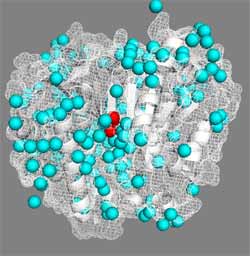Delving Into the Molecular Mechanism Behind Deep-Sea Bacteria’s Pressure Tolerance

Nobuhisa Watanabe, Nagoya University<br> <br>Observed water molecules for pressure-sensitive IPMDH at 580 MPa. The three newly penetrated water molecules at high pressure are shown here as red balls. <br>
A Japanese research team has been investigating how deep-sea bacteria adapt to such high-pressure conditions. They have identified a structural change that confers pressure-resistant properties on a particular protein found in bacteria. The findings, which the team will present at the meeting of the American Crystallographic Association (ACA), held July 28-Aug. 1, in Boston, Mass., may one day help guide the design of enzymes for use in high-pressure chemical industrial processes.
In general, pressure, like that caused by a water column thousands of feet deep, deforms proteins. As the proteins change shape, water can penetrate the protein’s interior. Some proteins are better able to resist this incursion of water, but the molecular mechanisms of the pressure resistance aren’t yet well understood.
“Our group is focusing on high-pressure protein crystallography, using 3-isopropylmalate dehydrogenase (IPMDH) as a model protein. The goal is to delve into the principles of the molecular mechanism of the pressure tolerance of proteins by comparing the structures of IPMDHs from organisms that thrive in high-pressure environments and those that are sensitive to high-pressure pressure environments,” explains Nobuhisa Watanabe, a professor at the Synchrotron Radiation Research Center, Nagoya University.
To create the high pressures necessary for their studies, the team uses a diamond anvil cell (DAC), which consists of two opposing diamonds with a gasket compressed between the culets (the small, flat facet at the bottom of the diamonds).
The team’s big discovery so far is that the initial water penetration at the molecular surface of the side opposite to the active site of IPMDH is unique.
“At the site of the penetration, there is a difference of amino acid between IPMDHs from bacteria that thrive in high-pressure environments and those that are sensitive to it. Based on this data, we substituted one amino acid at the site of the IPMDH from pressure-sensitive bacteria and checked its activity under pressure,” says Watanabe. “And as we expected, only this one residue-substituted IPMDH, which has 364 amino acids in total, achieved pressure resistance comparable to the bacteria that thrive in high-pressure environments.”
This means that it may soon be possible to synthesize designer pressure-resistant proteins. The team plans to continue their high-pressure studies of several other proteins to try to discover the physical principles behind pressure resistance mechanisms that enable bacteria to thrive in high-pressure conditions.
This news release was prepared for the American Crystallographic Association (ACA) by the American Institute of Physics (AIP).
MORE INFORMATION ABOUT THE 2012 ACA MEETING
The ACA is the largest professional society for crystallography in the United States, and this is its main meeting. All scientific sessions, workshops, poster sessions, and events will be held at the Westin Waterfront Hotel in Boston, Mass.
USEFUL LINKS:
Main meeting website: http://www.amercrystalassn.org/2012-meeting-homepage
Meeting program: http://www.amercrystalassn.org/2012-tentative-program
Meeting abstracts: http://www.amercrystalassn.org/app/sessions
Exhibits: http://www.amercrystalassn.org/2012-exhibits
ABOUT ACA
The American Crystallographic Association (ACA) was founded in 1949 through a merger of the American Society for X-Ray and Electron Diffraction (ASXRED) and the Crystallographic Society of America (CSA). The objective of the ACA is to promote interactions among scientists who study the structure of matter at atomic (or near atomic) resolution. These interactions will advance experimental and computational aspects of crystallography and diffraction. They will also promote the study of the arrangements of atoms and molecules in matter and the nature of the forces that both control and result from them.
Media Contact
All latest news from the category: Life Sciences and Chemistry
Articles and reports from the Life Sciences and chemistry area deal with applied and basic research into modern biology, chemistry and human medicine.
Valuable information can be found on a range of life sciences fields including bacteriology, biochemistry, bionics, bioinformatics, biophysics, biotechnology, genetics, geobotany, human biology, marine biology, microbiology, molecular biology, cellular biology, zoology, bioinorganic chemistry, microchemistry and environmental chemistry.
Newest articles

Properties of new materials for microchips
… can now be measured well. Reseachers of Delft University of Technology demonstrated measuring performance properties of ultrathin silicon membranes. Making ever smaller and more powerful chips requires new ultrathin…

Floating solar’s potential
… to support sustainable development by addressing climate, water, and energy goals holistically. A new study published this week in Nature Energy raises the potential for floating solar photovoltaics (FPV)…

Skyrmions move at record speeds
… a step towards the computing of the future. An international research team led by scientists from the CNRS1 has discovered that the magnetic nanobubbles2 known as skyrmions can be…





















